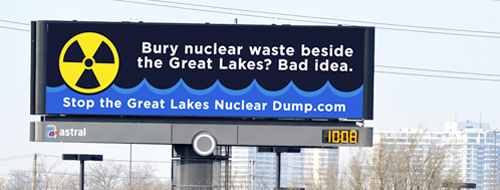 Stop the Great Lakes Nuclear Dump billboard, seen by hundreds of thousands of Toronto commuters dailyThe struggle against the Canadian nuclear establishment's proposal(s) to bury so-called "low" and "intermediate" level radioactive wastes from 20 reactors across Ontario, and perhaps even high-level radioactive wastes from 22 reactors across Canada, on the Lake Huron shore at or near the Bruce Nuclear Generating Station, can be most daunting. Bruce "hosts" 9 reactors (8 operable reactors, 4 each at Bruce A and Bruce B, plus 1 pilot plant -- Douglas Point -- permanently shutdown), one of the single biggest nuclear power plants in the world. Bruce has also quietly incinerated most or all of Ontario's "low" level radioactive wastes for 40 years, with untold radiological emissions. All this, just 50 miles across Lake Huron from Michigan, and upstream from tens of millions of Americans, Canadians, and First Nations/Native Americans who draw their drinking water from the Great Lakes. In terms of the vast fortunes being made by Bruce Nuclear, as well as the harmful radiological releases occurring and radioactive wastes piling up, Bruce is making a killing, while getting away with murder.
Stop the Great Lakes Nuclear Dump billboard, seen by hundreds of thousands of Toronto commuters dailyThe struggle against the Canadian nuclear establishment's proposal(s) to bury so-called "low" and "intermediate" level radioactive wastes from 20 reactors across Ontario, and perhaps even high-level radioactive wastes from 22 reactors across Canada, on the Lake Huron shore at or near the Bruce Nuclear Generating Station, can be most daunting. Bruce "hosts" 9 reactors (8 operable reactors, 4 each at Bruce A and Bruce B, plus 1 pilot plant -- Douglas Point -- permanently shutdown), one of the single biggest nuclear power plants in the world. Bruce has also quietly incinerated most or all of Ontario's "low" level radioactive wastes for 40 years, with untold radiological emissions. All this, just 50 miles across Lake Huron from Michigan, and upstream from tens of millions of Americans, Canadians, and First Nations/Native Americans who draw their drinking water from the Great Lakes. In terms of the vast fortunes being made by Bruce Nuclear, as well as the harmful radiological releases occurring and radioactive wastes piling up, Bruce is making a killing, while getting away with murder.
Canadian federal decisionmakers have just closed the opportunity to register to speak out in opposition to the proposed "low" and "intermediate" level radioactive waste DGR (Deep Geologic Repository, or, more aptly, DUD -- Deep Underground Dump), and environmental assessment hearings will be held in September and October. As insane as this proposal is (would YOU bury poison next to your well?!, as the group Stop the Great Lakes Nuclear Dump asks -- see photo, above left), the nuclear utility Ontario Power Generation (OPG), the nuclear utility comprised Nuclear Waste Management Organization (NWMO), and the Canadian Nuclear Safety (sic) Commission (CNSC) are racing, full steam ahead, to bury their forever deadly radioactive wastes within a mile of the Lake Huron shoreline.
But an antidote to such "nuclear madness" (à la Helen Caldicott's classic title) is at hand! In a recently published book, Tom Lawson of Port Hope, Ontario has shown that such insanity canbe stopped dead in its tracks. Crazy Caverns: How one small community challenged a technocrat juggernaut...and won! tells the inspiring story of a years-long struggle to prevent Canadian provincial and federal government decision makers from allowing Eldorado/Cameco's dumping of uranium processing wastes on the Lake Ontario shoreline.Tom has generously made the book available for free online -- simply click on the link to enjoy your free copy!
Tom has dedicated his "little book" to his wife Pat, as well as "to all those who accept responsibility as citizens in a free society, who agree that the best government is the one kept constantly on its toes by ordinary citizens with the courage to trust their common sense rather than the reassurances of the 'experts.' The experts do not know better than we know what is good for us."
Together, Tom and Pat Lawson, and their friends, neighbors, and colleagues in their tiny, picturesque, but badly contaminated community, have resisted the "biased bafflegab" of the "Pirates of Port Hope" headquartered in their town (Eldorado/Cameco, "Canada's National Uranium Company," as dubbed by Robert Bothwell's company-financed, dubious historical celebration of the firm, and the company's governmental henchmen). Together, this "small group of thoughtful, committed citizens" (à la Margaret Mead) did change the world for the better, by blocking the burial of "a million tons of radioactive and toxic waste 'out of sight, out of mind' under Port Hope's downtown waterfront."
Their important victory can inspire us now, as we struggle to resist OPG's, NWMO's, and CNSC's insane proposal(s) on the Lake Huron shore (more recently, incredibly, the vague specter of yet another DUD, this time for radioactive decommissioning wastes, has also reared its ugly head). In fact, Pat Lawson has spoken out strongly in recent years against the Bruce DUD(s), traveling in the nearby Georgian Bay, where her family has roots extending back many decades.
What can YOU do, right now, to help stop the Bruce DUDs?! Start by signing the Stop the Great Lakes Nuclear Dump petition, and urge your friends, family, neighbors, co-workers, etc. to do the same!





 July 30, 2019
July 30, 2019


